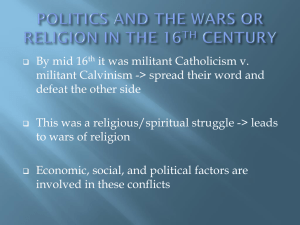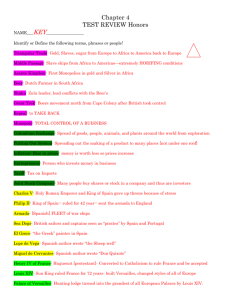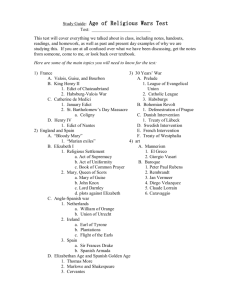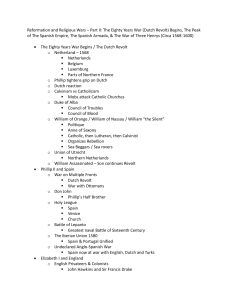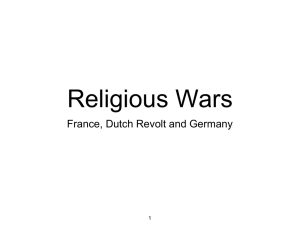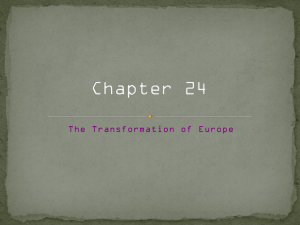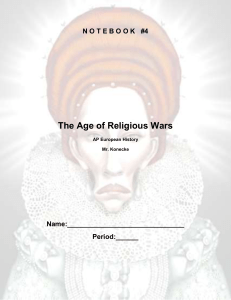The Age of Religious Wars and European Expansion The End of
advertisement
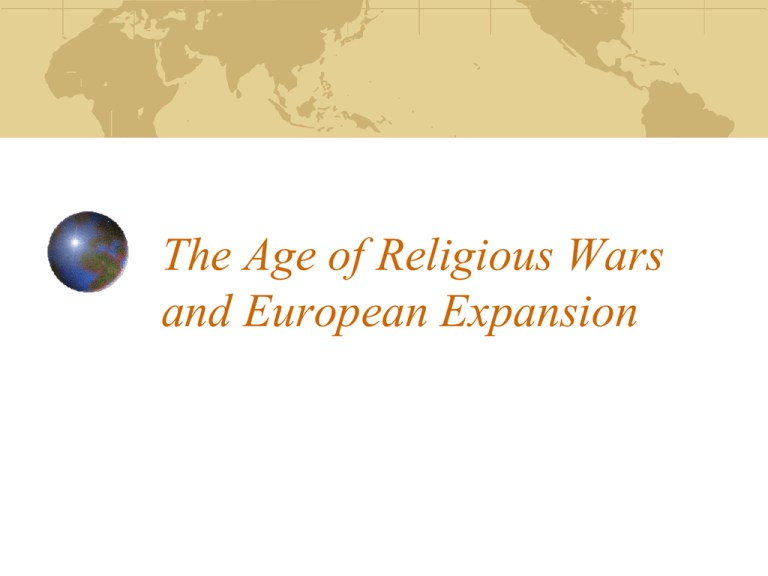
The Age of Religious Wars and European Expansion The End of The Hapsburg-Valois Wars Treaty of Cateau –Cambresis 1559 Spain wins Dominates Italy Ends dynastic and continues religious wars Larger modern armies with gunpowder Difficulties in France 1515-1559 Francis I – Places all France under royal law French National Language The Habsburg-Valois Wars were expensive The Nobility of the Robe – Raised money and made these families tax exempt The Concordat of Bologna – Supremacy of the Papacy but could appoint bishops and abbots = $$$$ Protestants are growing in number Religious Riots and Civil War in France Catherine D’ Medici Charles IX – Mama’s boy – 1560-74 Henry III – Wild parties with his boy friends and then drama-queen –1574-1589 Catherine wanted peace as long as her sons were ruling Clashes between Catholics and Calvinists - Huguenots St Bartholomew’s Day Massacre 1572 Henry of Navarre and Margaret Valois Colingy a Huguenot had gained control of Charles IX Henry Guise the night before the wedding attacked the and slaughtered the Huguenot gentry in Paris Wide-spread violence erupted The War of the Three Henry’s Henry III a Catholic joined with Henry Navarre the Protestant Guise and and Catholic nobles founded the Holy League The Politiques After fifteen years of devastation many want to reconcile. Catherine D’Medici dies, Henry of Guise and Henry III are assassinated “The Greatest Frenchman ever to live” Henry Navarre (IV) Drinker, lover and fighter “Paris is worth a Mass” – real politique The Edict of Nantes - 1598 The Netherlands Under Charles V The Low Countries The Hub of international commerce – Antwerp The Bourse - exchange Protestant reform and the Low Countries A mixed Federation Charles V – responds with condemnation Charles abdicates in 1556 Philip of Spain takes control of the Low Countries Revolt of the Netherlands Militant Calvinism Philip II appoints sister to quell the disorder – Margaret Her big problem was raising taxes Calvinists revolt in 1566 1568-1578 civil war in Holland The King sends 20,000 troops to the Low Countries Duke of Parma are appointed to crush revolt William of Orange leads the home team The Spanish Netherlands and the Union of Utrecht Ten Southern provinces – Spanish Habsburgs – Landed nobility Seven Northern – Protestant Union of Utrecht –Commercial aristocracy The Union asked Elizabeth I for aid The English Dilemma Help the Union and anger Philip II Not Help and await the invasion from the Spanish The death of William The collapse of the wool trade The fall of Antwerp Philip and the Armada -1588 The Escorial –Symbol of Philips values Philip the Man As a young man was a party animal After the death of his fourth wife he becomes somber and pious In terms of religious tolerance he was inflexible The Armada Sails 9 May 1588 The death of Mary Queen of Scots 130 vessels sail to England Drakes plan and poor sailing – 65 Spanish ships return home The Thirty Years War 1618-48 Starts as a religious war and ends as way to keep Habsburgs in check and Germany divided Four phases Bohemian Danish Swedish French Discovery, Reconnaissance and Exploration 1450 -1650 The geography was not understood Migration and colonization Economic exploitation and religious dominance Gold, God, and Glory Muslim Expansion Muslims expand toward western Europe Medieval trade routes interrupted Spain and Portugal Spain – Central government provides support Portugal – Geographic advantage Other centralized states followed France England On to the East India… Spices Ethiopia – Prester John Prince Henry the Navigator The laboratory – Earth Cartography Down the coast of Africa Diaz –1487 Da Gama – 1497 reaches India The Europeans take over Ships with powerful guns Buddha came to China on white elephants, Christ was borne on cannon balls Begin to control the Indian ocean and Asian trade. Columbus sails 1492, financed by Spain. Technology and attitudes stimulates exploration Compass Astrolabe Caravel Cannons The psychology of the Renaissance Gold, God and Glory Columbus Devout Catholic Messenger of God Excellent sailor Estimated the distance from Portugal to Japan was about 2800 miles ( 12000) Little interest in government Later Explorers 1493 – News of Columbus’s voyage travels throughout Europe Natives are Christianized, killed and destroyed by disease 1519 Magellan The Conquistadors Cortez – Aztecs - Mexico Pizarro – Incas - Peru Economic Effects of Spain’s discovery in the New World 16th century – The Golden Age of Spain Spanish economy could not the meet demand of rising population Price increases hampered the international demand for Spanish goods The Price Revolution – State debt not paid Spanish inflation spread through Europe Nobles and poor were hurt middle class did OK Colonial Administration Spain Viceroyalties Audiencia Intendants – later PotrugaL – Corregidores Mercantilist – Strict control of Brazilian production Slave labor Status of Women Arranged unions were discouraged Double standards were discouraged regarding infidelity Emotional and physical attraction were not sound reasons for enduring relationships Standards of beauty 1566 pope expels prostitutes, but has to rescind the expulsion due to lost revenue Women continued single women in the 16th and 17th centuries worked in many occupations Married women assisted their husbands Upper- class… ex nuns were encouraged to marry From one master to another? Marriage the only occupation for upper class protestant women. Malleus Maleficarum Why the witch craze Perhaps the Reformation Explain what is not understood A way of eliminating non-conformists or rivals Christian repression of sexuality Perhaps as many 60,000 Declines in the late 18th century Witches Everywhere? Smart and stupid alike- believed in witches Individuals that could mysteriously harm others Could cause blindness and impotence Majority were 50-70 crippled and pockmarked females And… they talked back to men
